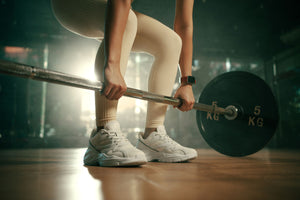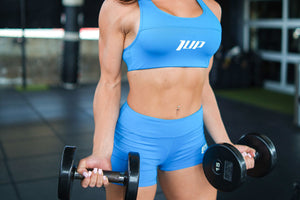Strong, healthy shoulders are something everyone wants. It’s true — buff shoulders are one of the best ways to improve your overall physique. After all, big shoulders mean big arms!
Whether you’re a man looking to beef up your deltoids or a woman looking to tone up, this is our in-depth guide to the 8 best shoulder exercises for men and women. Follow this guide and enjoy sublime shoulder workouts here on out!
Shoulder Anatomy
If you’re struggling to grow your shoulders (and be honest, who isn’t?), you might need to take a step back. It’s important to consider why when you’re performing a particular exercise — the exercise must match your goal. Of course, understanding the role of different exercises takes a quick primer on shoulder anatomy.
Ball and Socket Joint
The shoulder is a ball and socket joint, much like your hip. As the name implies, the "ball" of the shoulder (the head of the humerus, the long bone in your upper arm) rotates inside the socket.
There are some additional joints and technical details that come into play here — suffice it to say that this ball and socket joint allows for incredible mobility (and weakness).
Deltoids Galore
The deltoids are the visible muscle groups of the shoulder. These are three distinct muscles that work in concert with each other to produce movement — you’ll see these called the “heads” as well.
The three heads of the shoulder are:
- Anterior (front) deltoid
- Medial (side or lateral) deltoid
- Posterior (rear) deltoid
Each deltoid has a handful of central tasks they must perform.
The anterior deltoid focuses on shoulder abduction (movement away from the body’s midline) when the shoulder rotates externally. The medial (or middle) deltoid performs shoulder abduction when the shoulder internally rotates. The posterior deltoid does all sorts of good things: shoulder external rotation, transverse abduction, and plenty more.
Sound technical and complicated?
You’re right.
What Does It All Mean?
You’ve been reading for a while now. Get up out of that chair and get ready!
Front Raise
Take your hand and make a tight fist. From a neutral standing position, raise your first directly up to your eyes. What deltoid head comes into action?
Answer: anterior deltoid. You’re using the front of your shoulder to make that movement happen.
Quick quiz: What shoulder muscle helps with pressing movements, like the bench press?
Answer: That’s right — the anterior deltoid. That front shoulder muscle is what helps move objects away from the body in a pressing motion.
Side Raise
Now, back to your neutral posture. With your arms at your side, try to raise each arm parallel to the floor. That’s the lateral deltoid at work — it’s bringing your arm up, parallel to the floor.
Shoulder Retraction
As for the posterior deltoid, get back to your neutral standing position. Stick both arms straight out, at eye level. Now, draw each fist straight back to your ears.
That’s the posterior (or rear) deltoid at work. This muscle helps the shoulder retract the arm back towards the body.
What Are the Best Shoulder Exercises for Men and Women?
1. Seated or Standing Military Press
The seated (or standing, your preference) military press is a staple for all things shoulder and for good reason — there’s something definitively awesome about lifting heavy things above your head.
How to Perform This Exercise
The Military Press is deceptively simple to perform.
First, if done standing, you’ll need to place a barbell on a power rack that is about as high as your chest. If a rack isn’t available, you can clean the barbell from the floor and get it in position that way.
Second, with the barbell on the rack, approach the bar. Place your hands around the bar with your palms facing outwards (away from your body). The width of your grip depends on your level of comfort and flexibility — start with your hands slightly more than shoulder width apart and see how it feels. Keep your feet in line with your shoulders.
Third, place the barbell on the little “shelf” created by the front of your shoulders and your collarbone. Adjust the barbell up slightly so that it is resting on your upper chest if you lack the flexibility for the first position.
Fourth, press the barbell straight overhead and lock your arms at the elbow. You should need to duck your chin back from the bar as it presses overhead — you don’t want to press forward, but up.
Fifth, lower the barbell down to the first starting position in a controlled fashion.
What Muscles Does It Work?
The Military Press works the anterior deltoid and a dash of the medial head. As an added bonus, it also works the tricep (necessary for locking out the weight overhead).
Aim for at least x4 sets of eight to ten repetitions each. This is an exercise for heavy weight!
2. Arnold Press
Popularized by the legend of bodybuilding himself, the Arnold Press is responsible for one of the most impressive physiques in the history of the sport.
How to Perform This Exercise
First, sit on a bench with two dumbbells of an appropriate weight within reach. Take each dumbbell and position them directly in front of you. The starting position is rather unique — you’ll start with the weights in the end position of a traditional bicep curl (weights in your palms, facing towards you, arms bent).
Second, press and rotate the dumbbells up and out. At the top of the movement, the dumbbells should be facing directly outwards (palms facing away from you).
Third, carefully lower the weights back to their starting position (palms towards you).
What Muscles Does It Work?
The Arnold Press is magical — it works all three heads of the shoulder. The anterior deltoid comes into play for overhead pressing, the medial head helps with the rotation and pressing, and the rear deltoid is vital for both rotation and transverse extension.
Aim for multiple sets (at least three to four) and a minimum of 10-12 repetitions. We want volume!
3. Dumbbell Side Lateral Raise
The dumbbell side lateral raise is something we’ve already performed up above, at the start of this article. Remember how we held our fists out to the side and then lifted our arms parallel to the ground? Now, try it with weights.
How to Perform This Exercise
First, you’ll need a few dumbbells of an appropriate weight. Side raises are hard — start light and work your way up.
Second, stand in a neutral position with the weights at your side. You’ll want the dumbbells facing inwards — your palms should be facing you, in other words.
Third, raise your arms straight up until they are parallel to the floor. At the top of the movement, your palms should face straight downwards to the floor.
Fourth, lower the weights carefully and repeat.
What Muscles Does It Work?
The side raise is brutally difficult and equally effective — it trains that amazing medial deltoid that really rounds out your shoulders. Whereas the Arnold and military presses build mass all around, the side lateral raise is what gives you that “cannonball” look.
Aim for multiple sets (at least three to four) and a minimum of 10-12 repetitions.
4. Dumbbell Front Raise
Another goodie for the front shoulder, the dumbbell front raise is a fantastic option for building up that shirt-busting front shoulder mass.
How to Perform This Exercise
First, select a few dumbbells and stand in a neutral position. Keep your arms in front of you with the weights resting against the front of your body. Like the side raise, your palms should be facing inwards (towards the body’s midline).
Second, lift one arm forward until the arm is parallel to the floor. Don’t swing or compromise your stability — keep it all in the shoulder. At the top of the movement, your palm will face straight downwards.
Third, lower your arm. Rinse and repeat by alternating arms.
What Muscles Does It Work?
As you might imagine, the dumbbell front raise is a killer for the front deltoid. If you’re looking for an exercise to pump up the front shoulder, this is what you want.
Aim for multiple sets (at least three to four) and a minimum of 10-12 repetitions.
5. Bent-Over Reverse Dumbbell Raises
Something for the rear deltoids, perhaps? The bent-over reverse dumbbell raise is exactly what you need.
How to Perform This Exercise
First, grab a few dumbbells and get into a neutral standing position.
Second, hinge at the hips until you’re nearly parallel to the floor. Keep a flat back and a slight bend in the knees, and then raise each dumbbell (palm facing inwards to the body’s midline). Raise the weight until your arms are parallel to the floor.
Third, lower the weight (carefully) and repeat.
What Muscles Does It Work?
The bent-over reverse dumbbell raise is perfect for giving your posterior deltoids some love. Often overlooked, this part of the shoulder is typically not trained as much as the front and side heads.
Aim for multiple sets (at least three to four) and a minimum of 15-20 repetitions. This is an exercise for low to moderate weight and lots of volume.
6. Cable or Pulley Face Pull
A vital exercise for shoulder health, the face pull is something you need to do. If there’s one exercise you’ll thank yourself for doing 30 years from now, it’s the face pull.
Do it.
How to Perform This Exercise
You’ll need a cable or pulley machine.
First, grab a rope or handle and attach it to the machine. Set the height to be about eye level.
Second, grab each end of the rope and pull your fists directly towards your ears using your shoulders. As you bring the fists back, rotate the shoulder so your fists finish the movement pointing upwards. You want your knuckles to point straight to the ceiling as you retract your shoulders — imagine you’re trying to pinch a coin between your shoulder blades.
Third, slowly return the weight and do it again.
What Muscles Does It Work?
Face pulls are vital for scapular retraction, rotator cuff health, and posterior deltoid development. There’s no argument here — if you bench press, Arnold press, or military press, you need face pulls to build strength in opposition to them.
Do face pulls! We’re serious.
Aim for multiple sets (at least three to four) and a minimum of 15-20 repetitions. This is an exercise for low to moderate weight and lots of volume.
7. Cable Front Raise
A variation of the dumbbell front raise, but with a twist. Use a cable or pulley machine! You’ll build muscle in an entirely new way — muscle isolation is a lot easier to achieve here.
How to Perform This Exercise
First, you’ll need a cable machine. Set up a rope or single-hand grip on the machine. For this exercise, having the weight low is best — you want the grip to rest wherever your hand sits when standing.
Second, face away from the machine. Stand with the grip in your hand, arm in front of your body, palm facing towards you. Lift the arm slowly (keeping the palm facing the floor) until the arm is parallel to the floor.
Third, lower the weight carefully. Rinse and repeat.
What Muscles Does It Work?
The cable front raise is an excellent supplement to the dumbbell front raise. Cables provide constant tension on an isolated muscle — that means a great pump.
Aim for multiple sets (at least three to four) and a minimum of 15-20 repetitions. This is an exercise for low to moderate weight and lots of volume.
8. Band Pull-Apart
The band pull-apart is another exercise for shoulder health, scapular retraction, and injury prevention.
How to Perform This Exercise
You’ll need a resistance band of appropriate strength. Remember, weight is not the concern here — shoulder health is.
First, stand in a neutral position. Take one end of the band in each hand and raise your arms until they are parallel to the floor.
Second, pull the band apart horizontally and parallel to the floor. You’ll want to keep your palms facing downwards the whole time. The goal here is to create movement in the scapula and retract the shoulders — keep the shoulders back the whole time.
Third, slowly return to the starting position and rinse and repeat.
What Muscles Does It Work?
The band pull-apart works the rear shoulder muscles, rotator cuffs, and all the tiny stabilizer muscles in your shoulder. Like face pulls, band pull-aparts are indispensable and must become part of your workouts.
It’s not a bad idea to throw in several sets of these at the end of every pressing workout, even if you’re not working shoulders that day. For example, band pull-aparts are fantastic to finish out a chest workout.
Aim for multiple sets (at least three to four) and a minimum of 15-20 repetitions. This is an exercise for low to moderate weight and lots of volume.
What About Sets and Repetitions?
There’s no magic to building muscle. Lots of sets, lots of repetitions, and lots of weight. For heavy compound movements like the Military Press, stick to lower reps and heavier weight (think four sets of 8-10 repetitions). For isolated movements like the Cable Front Raise, emphasize high volume and relatively lower weight.
If you’re doing the above and not seeing results, add another shoulder day to your regimen.






